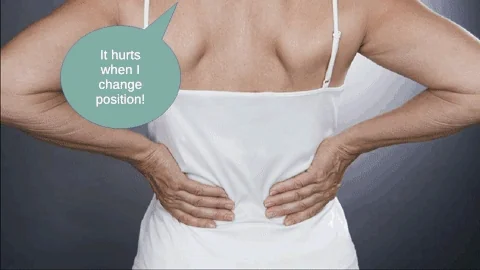
‘At least you haven’t broken anything……’
…. was what the previous practitioner had said to Julie when she complained about her back pain, following a fall onto her bottom The practitioner had examined her, feeling her spine, and had not found any tenderness, and had assumed that this meant that nothing was broken. She was wrong.
The most common spinal fractures are deep. This means that they cannot be felt when the patient’s spine is examined. There is no superficial tenderness, because the pain is coming from a structure deeper inside: the vertebral body.
The structure of the vertebral body is like a honeycomb. Light and strong. As we get older, however, the honeycomb becomes less strong. This is called osteopenia, and if it progresses, it is classified as osteoporosis. As we progress along this trajectory, our fracture risk increases. The most common fractures are of the spine, hip and wrist. Fractures of the spine cause back pain, which is why we see them quite commonly in our practice. They are often referred to as ‘compression’ fractures.
Compression fractures occur when we fall onto our bottom (like Julie), fall on stairs, or slip on ice. They can also be caused by lifting something too heavy, like a dustbin, in the days before wheelie bins, or a suitcase off the carousel in an airport. People who are have osteoporosis are much more vulnerable to compression fractures. There was a useful review article about osteoporosis in this weeks’ edition of JAMA (1)
How do we recognise if a patient has a compression fracture? Firstly by the story that they tell us: a fall or a lifting injury will alert us to the possibility. Some patients are more vulnerable because they have been on steroids, or because they drink too much alcohol (2) and caffeine, or they smoke (3). Certain medical conditions, like rheumatoid arthritis, liver and kidney disease, also increase our risk of osteoporosis (4).So a thorough case history when we first chat with a patient is really important.
What is most striking about examining a patient with a new compression fracture is that it’s very painful for them to get down onto our treatment couch when we want to assess them. It’s also very painful to turn over, and for them to then get off the treatment couch. This contrasts quite dramatically with the lack of tenderness of the spine to touch. This significant mis-match is not mentioned in the recent JAMA article, and might explain why so many practitioners fail to realise the cause of their patients back pain: a compression fracture. It’s reckoned that two thirds of compression fractures are missed in clinical practice (1)!
It’s important that a fracture is identified, because manipulative treatment of a compression fracture is painful, and to be avoided! We tend to favour use of taping techniques to stabilise the area (5). We will also use acupuncture techniques, as this seems to be quite helpful for some patients (6).
Definitive identification of a compression fracture is by simple X-Ray, where the ‘wedge’ deformity of the compression fracture may be seen. Once the fracture is confirmed, the patient should really have a bone density scan, to see where they are on the scale of fracture risk. The compression fracture that the patient currently has will heal, albeit slowly. The main task now is to try and prevent future fractures. These measures may include strengthening exercises, balancing exercises, reviewing footwear, dietary changes and nutritional changes. There may be a case for taking a calcium and Vitamin D supplement.
Patients with significant osteoporosis may be advised by their GP to take a medication to reduce the resorption of bone by the body (Alendoronate, Risedronate, Denusomab) for a few years.
Our patient, Julie, did gradually improve and got back to a normal fully functioning lifestyle. Unfortunately, not all patients become completely pain free, in particular those whose posture is significantly altered by the compression fracture, so what we really want to do to treat compression fractures is to prevent them in the first place:
- Plenty of exercise for muscle strength
- Exercise that improves balance
- Minimal alcohol and caffeine consumption
- No smoking
- use a baby ‘night-light’ on the landing at night.
- Use of weather-appropriate footwear
- Avoiding ‘high-risk’ activities: especially unnecessary heavy lifting
A resource that you might find helpful is the Royal Osteoporosis Society.
References:

